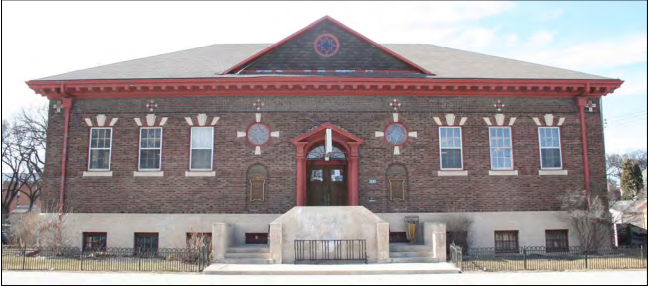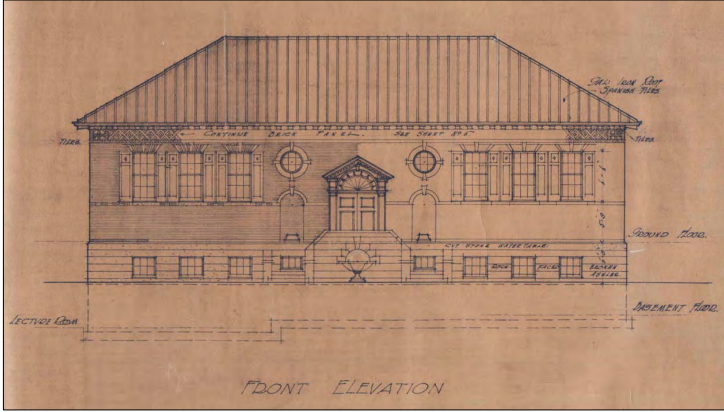
/ Blog
February 5, 2020
The New Edition of the St. John’s Library
The stately St. John’s Library stands, newly renovated, at 500 Salter Street as a testament to the power of libraries both today and at the turn of the 20th century.
Today, there are 20 libraries spread out across Winnipeg’s neighbourhoods but when the St. John’s Library opened in 1915, it was one of just three. By this point, the library system in Winnipeg was hardly new, but having a purpose-built space for the city’s collection of books was.
 |
| The St. John’s Library. Source: Murray Peterson, City of Winnipeg. |
Created in 1848, Winnipeg’s library system had spent several decades (1888-1905) in Winnipeg’s ‘Gingerbread’ City Hall, a space that was growing increasingly crowded by the end of the 19th century. Winnipeg, apparently a city of avid readers, kept demand high and the library added a new juvenile section in 1899. By the start of 1900, it was apparent that a new space was needed and librarian J.P. Robertson hatched a plan.
Robertson wrote to wealthy American philanthropist Andrew Carnegie for financial assistance. By 1903, Carnegie was well-known for funding the creation of libraries across North America. With the steadfast belief that libraries and literacy would allow individuals to better themselves, Carnegie would help fund the construction of 2,509 libraries between 1883-1929. He was not just freely building libraries wherever he pleased, however. The community had to ask for the library and had to be willing to contribute financially both to the construction and to subsequent repairs.
Still, with Carnegie’s help the construction of a new library became significantly cheaper. And it was with Carnegie’s help that the Carnegie Library on William Avenue opened in 1905. This was the first official library building in Winnipeg, and suited the city well. Still, Winnipeg was expanding rapidly to the north and to the south. As newer neighbourhoods developed, small lending stations were set up in drugstores, missions, schools, and even hospitals. Nearly 500 books were cycled through these locations every few weeks! By 1913, there were 35 locations to move books to and from, and it was time to consider constructing a new library branch.
James McCarthy, Winnipeg’s Head Librarian in the 1910s, wrote to Andrew Carnegie. McCarthy was requesting funding this time to not build one, but two library branches: one to go in Winnipeg’s South End, and another for the North End. The Carnegie Foundation agreed to give $35,000 for each branch, and this led to the creation of both the Cornish Library (at the Corner of Sherbrooke and West Gate) and St. John’s Library.
 |
| The front elevation of the St. John’s Library, 1911. Source: City of Winnipeg Archives. |
Though both libraries would open in 1915, the St. John’s Library opened first – and before it was fully completed. Apparently public demand was so high that the library opened on June 2nd, 1915, with barely any furniture inside. Hundreds of people, local dignitaries, and Mayor Waugh were present at the opening ceremonies as an orchestra provided musical entertainment for the crowds.
The library structure itself, like many other Carnegie libraries, is classical in style. It was architect J.N. Semmons who designed the building, relatively earlier into Semmon’s lengthy career in Winnipeg. The façade is largely symmetrical, with an arched entranceway supported by unfluted columns. Inside the library was built to serve as a public space – with lots of room to curl up with a book, and many shelves to explore.
The library did well for itself, and circulation remained high (higher than the Cornish and the Carnegie, in fact). Over the course of the 20th century, Winnipeg’s library system would continue to grow. Bookmobiles took books from library branches to other neighbourhoods, and then other neighbourhoods built their own libraries.
Still, the St. John’s Library kept going strong – until it was nearly closed completely in the early 1990s. Strapped for the funds, the Winnipeg Public Library was experimenting with cost-cutting measures including closing smaller branches during certain days of the week, and were beginning to contemplate permanently closing a branch.
Among those suggested for closure were William Avenue, Brooklands, Cornish, and St. John’s. Eventually, it was decided that the Brooklands Library would close as the building was no longer up to code and circulation was flagging. The McPhillips Library was also closed, and the two were replaced by the William Stephenson Library on Keewatin Street.
More recently, the St John’s Library underwent a significant rehabilitation project. In 2011, the St. John’s Library was designated by the City of Winnipeg and a year later public consultations began for the prospective renovation project. The plan was to create a new accessible entrance to the historic building and to update the space to meet the needs of today’s library users while preserving many of the historic aspects of the structure.
Public City Architecture was responsible for the renovation’s design, which both added the accessible entrance but also reimagined the building’s interior. As per the heritage designation multiple aspects of the building were expected to be maintained, including: the façade, including the arched entrance and geometric brickwork, the two fireplaces on the interior, dumbwaiter in the staff area, and wood finishings.
The St. John’s Library closed for renovations on August 26th, 2017. Ultimately, the project cost $2.8 million and funding came from all three levels of government, and from community support.
When the St. John’s library reopened on July 5th, 2019, the opening was not quite as grand as the one they’d experienced in 1915 (there was no orchestra making noise in the library this time). Still, the project was met with excitement and many turned out to explore the renovated facilities. The layout of the library was changed, moving the adult, children’s and teens section to the main floor and added needing study and leisure spaces. A dedicated computer area was also added.
In the new extension, there is a sunny reading area as well as an accessible entrance and washroom.
Even with the new construction work, Public City Architecture not just maintained but restored many of the libraries original finishings, allowing the St. John’s Library to continue serving its community the way it has for the past 105 years!
SOURCES:
City of Winnipeg Historic Resources Branch | 500 Salter Avenue
City of Winnipeg Historic Resources Branch | 380 William Avenue
Winnipeg Public Library | Renovation of St. John’s Library
CTV News | New look for 100+ year old library in North End comes with accessible features
Public City Architecture | ST JOHN’S LIBRARY ADDITION AND RENOVATION
Eve Dutton, Kathleen Williams, More Than Books, A History of the Winnipeg Public Library
Winnipeg Evening Tribune
THANK YOU TO THE SPONSOR OF THIS BLOG POST:

Written by Sabrina Janke on behalf of Heritage Winnipeg.










